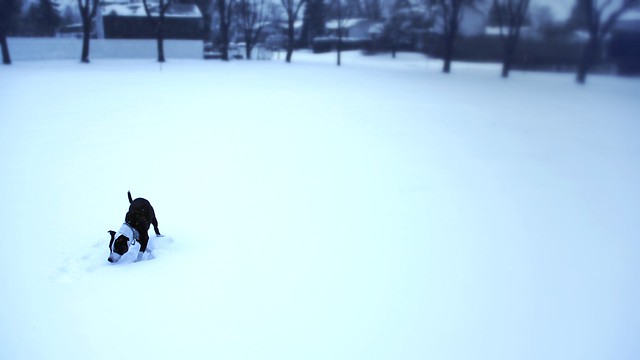Pets add so much fun and love in our lives that it is no wonder we have as much as 164 million furry friends throughout homes in the United States.* But as winter’s cold and snow keeps us humans inside, it is important to realize that our pets need much of the same sheltering and care.
“Our highest times of lost animal intake is after heavy winds, snow, and thunder storms,” said Operations Manager Susan Fredinburg of the Humane Society of the South Platte Valley. This low-euthanasia and not-for-profit shelter takes in strays and lost animals from seven cities in the Denver area, and does their best to either reunite a pet with their owner, or prepare the animal for adoption by another family. Susan said that the changing weather conditions she mentioned cause pets to jump backyard fences, dig holes underneath, and generally look for ways to escape their current conditions.
Another concern is that pets used to being indoors with owners, or even outdoors in Colorado’s hot summer conditions are not acclimated properly for the heavy cold and snow we experience here. This means that those beautiful thick coats on Fido and Fifi are really not doing the job to keep them warm in winter. So before you head Outdoors with your pet this winter, please keep the following notes and tips in mind.
Dog Issues
For your dog, these are some of the common problems associated with leaving them Outdoors without your care in winter:
- Frostbite – Frostbite and freezer burn happen when your dog is left outside too long, and part of Spot’s body actually freezes. Frostbite happens mostly on paws, ears, tails or scrotums of your pet. Look for pale white or blue skin that, as your pet warms up, turns red and swollen. Please take your pet to your veterinarian as soon as possible, if this happens. This is an emergency condition.
- Hypothermia – This is another very dangerous situation. When Buddy is left outside, his body temperature will drop. He may begin shaking vigorously in an effort to keep warm, and then become lethargic or even comatose.Although hypothermia is the biggest threat to puppies, older or sick dogs and breeds without a thick undercoat (huskies, German shepherds, malamutes and the like), even “northern” dogs, if their coats become wet, will have a hard time.And don’t think that leaving a dog in a cold car is enough protection either. If at all possible, don’t leave dogs outside for prolonged periods in winter.
- Dehydration – Susan said that a lot of owners or dog caregivers put a bowls of water out for Champ as they leave for work, but come home to a frozen water dish and a dehydrated dog. “Some people think that if the dog has snow to eat, he’ll get plenty of water that way,” said Susan. “Unfortunately, this isn’t true. There isn’t enough moisture in our snow to keep up with the needs of your dog.”
- Chemical burns and damage—Another big problem for outside dogs, or even dogs you take on walks in the snow is the damage that can be done to their paws. Snow melting pellets, salt, and other chemicals used to melt the ice on your driveway can get stuck between the pads on your dog’s feet. As they ingest the chemicals while licking themselves clean, your dogs can become quite ill. Even leaving small ice packs between the pads will cause discomfort and can dry your dog’s skin. “A paw is like a human hand,” said Susan, and the same care you give your own fingers needs to be extended to your dog for his safety.
Cat Issues
For your cat, the challenges are equally dangerous. Their smaller size makes them even more susceptible to cold winter conditions:
- No cat can grow a “winter coat” and will suffer from frostbite and hypothermia very quickly.
- Little Mittens seldom comes when called, making it much easier to accidentally leave her out too long.
- Angel is small enough to be great coyote or even hungry fox bait, and when she looks for shelter from the cold it is likely to be in places that these predators naturally hunt – rabbit dens, rodent homes, or small, tight areas dug into snow banks.
“I’d like to see all cats kept inside,” said Susan. “It’s safer there. I know owners want their pets to have fresh air, and you can put them in a covered kennel if you really want them out, but please keep them safe, and bring them in when its cold.”
Other Things You Can Do To Help Your Pet With Winter’s Cold
If you must leave your pet outside, here are some good products to use to help avoid an emergency vet visit:
- Buy and use dog booties. They will protect your dog from collecting inappropriate chemicals and ice chunks. If Ace will not cooperate with the booties, just take an extra few minutes at the end of your walk to wash his paws in warm water.
- Put winter jackets on the most fragile dogs—short coat breeds like Dobermans, toy breeds, puppies, old dogs, and dogs who are recovering from illness.
- Use heated water dishes for any outdoor pets. These are generally available at your local pet store and are well worth the extra dollars to keep Oreo hydrated.
- For outdoor kennels, keep them insulated with straw. Blankets tend to freeze and don’t provide the winter protection that straw will.
While Outdoor Living is great even in winter, its best to do it in reasonable amounts of time. And remember, your pet’s favorite place in the world is by your side. If you go out, she’ll be happy to accompany you, but when its time for you to come back inside, bring Max with you. You’ll both be happier.






Leave A Comment